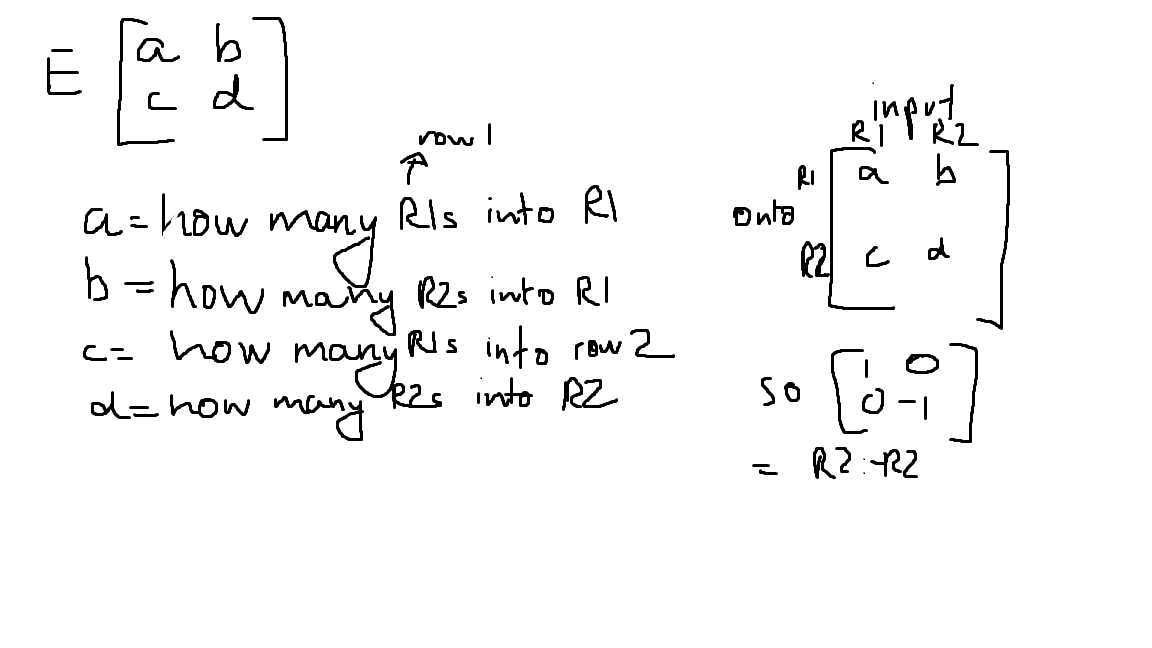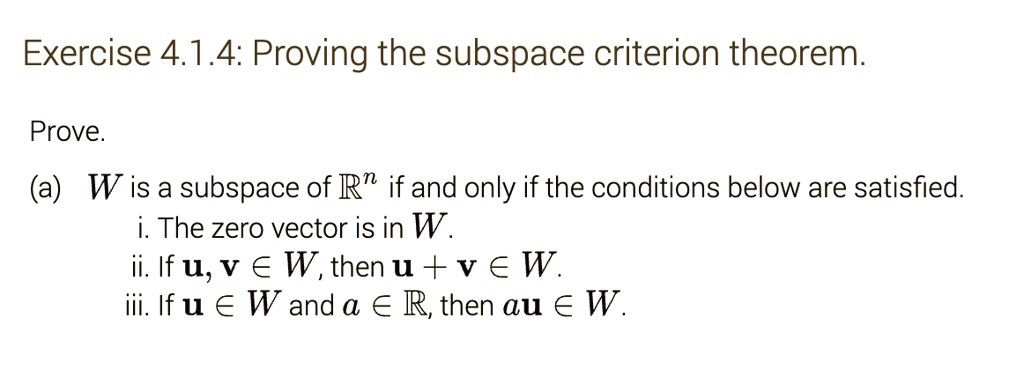-
The columns of A are also referred to as _______ vectors
feature
-
What do you call the set of all the possible linear combinations made from the vectors in a set?
The span of those vectors
-
What does it mean for an SLE to be inconsistent?
It has no solution
-
What is the trivial solution?
x1, x2, x3.... xₙ all equal 0 for Ax = the 0 vector
-
What is the particular solution of an sle
The (constant) vector that is independent from any free variables
-
If Ax = b has a solution p (Ap = b), then all solutions are obtained as _________ where ___ is any solution of Ax = 0
x=p + vₙ, vₙ
-
When do you have linear independence?
(in homogeneous matrices) When the only solution is the trivial solution // No (column) vector can be expressed as a linear combination of the others
-
If there are any free variables after reducing the homogeneous matrix, it has a _______ solution
non-trivial
-
When is a transformation linear?
T(u + v) = T(u) + T(v) && T(alpha*u) = alpha*T(u) && T(zero vector) = zero vector
-
T: R^m -> R^n. R^m is the ______ and R^n is the ________
domain, codomain
-
Is every matrix transformation a linear transformation?
Yes
-
Can every transformation be represented as a matrix transformation?
Yes
-
Transformations: T(x) is called the _______
image
-
If T: R^m -> R^n is a linear transformation, there is a _______ matrix A such that ___________
unique, Ax = T(x) for all x in R^n
-
Unit vector notation
e₁, e₂, etc. One for each dimension the vector goes in.
-
The basis of a column space is the set of all its __________
linearly independent (pivot) columns
-
Define surjective
aka "onto" - every vector b in R^m is the image of at least one vector x in R^n
-
Define injective
aka one-to-one - every vector b in R^m is the image of at most one vector x in R^n
-
Iff a linear transformation is injective, then ________
T(x) = 0 vector has the trivial solution
-
where is the line of symmetry in a symmetric matrix
along the diagonal from the top left to the bottom right (same as the 1s in I)
-
Notes row operations as matrices E

-
Conditions for a matrix to be invertible
Determinant !=0; A must be a square matrix, and have no free variables (rref = I, only solution to homogeneous is the trivial solution)
-
If A is an nxn invertible matrix, then for every vector b in R^n, the equation Ax = b has ________
the unique solution x = A^-1 b
-
(A^-1)^-1 = ______
A
-
(if A^-1 and B^-1 exist) (AB)^-1 = _________
(B ^ -1)(A^-1)
-
Does the order of two matrices affect their product?
YES
-
basic 2x2 determinant formula
ad - bc
-
Formula for inverse of a matrix using the determinant
(1/|A|) [d, -b//-c, a] (// = new row)
-
Transpose of a matrix definition (A^T)
flipping the matrix on its diagonal (top left to bottom right), or switching the rows with the columns
-
(A^T)^-1 = _____
(A^-1)^T
-
Note: The determinant tells us how the area/volume scales when applying the transformation T defined by matrix A
T(e1) = Ae1 = first column of A, and so on
-
projv (u) is the projection of _ onto _
u,v (it lies along v, and the difference vector is perpendicular to u)
-
formula for orthogonal projection proj v (u)
(u.v/v.v)v
-
If a matrix has no free variables, can its determinant be 0?
No
-
How to check if a set of vectors form a basis
Put them as columns in a matrix, check for linear independence (check if the determinant isnt zero);
-
What is trace(A)
The sum of its diagonal elements
-
What is trace(A) equal to?
The sum of its eigenvalues.
-
When is a matrix not diagonizable?
The number of dimensions of the eigenspace of any eigenvalue is lower than its multiplicity
-
steps to orthogonally diagonalize: A = PDP^T
Find the eigenvectors. Check if they are orthogonal. Orthogonally project the vectors that are not orthogonal to another, then find the perpendicular component (the difference between the projection and the projected vector). Normalize all the vectors.
-
steps to check for injectivity and surjectivity of a linear transformation with given outputs
Apply the transformations to the column vectors of I, using the properties of linear transformations. Combine these two vectors into a single matrix. If there is a pivot in every column, the matrix is injective. If there is a pivot in every row, the matrix is surjective.
-
Conditions to be a subspace

-
How to find two linearly independent vectors orthogonal to Nul A
get RREF, select two rows with pivots as vectors
-
Row A is _______ to Nul A
perpendicular (orthogonal) (⊥)
-
Does doing row operations change the column space?
Yes
-
Does doing row operations change the row space?
No
-
Row space is equivalent to Col(__)
A^T
-
How to find the determinant for big matrices when a row has only one nonzero element

-
Test for orthogonality
a.b = 0 vector (dot product)
-
Nul(A^T) = _____
number of rows - col(A^T) = number of rows - row(A)
-
Can the basis of a column space be extracted from the RREF?
No, as row operations change the column space

